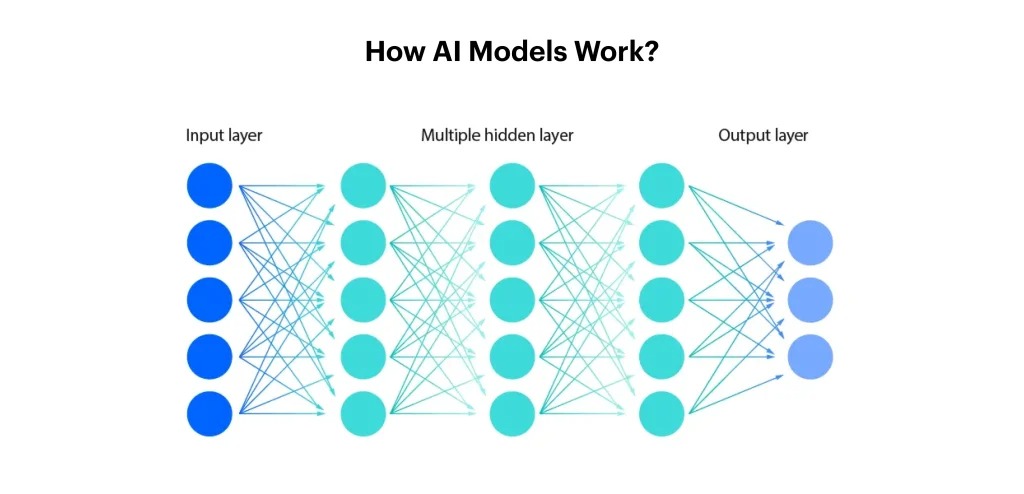How Does AI Actually Work? It's Not Magic, It's More Like Gardening
In the last lesson, we learned that AI is the quest to build machines that can think. But how does a machine, a thing of metal and silicon, actually "learn" to do something like recognize your face or translate a language? It's not magic, and it's not a person hiding inside the computer. The answer is surprisingly elegant: AI learns by looking at countless examples.
Imagine you're teaching a toddler the difference between a cat and a dog. You don't write down a long list of rules like "If it has pointy ears AND whiskers AND a long tail, it's a cat." Why? Because some cats have folded ears, and some dogs have whiskers. It's too complex!
Instead, you just show them pictures. "This is a cat." "This is a dog." "Here's another cat." Over and over again. Eventually, the child's brain starts to figure out the patterns on its own. They form their own fuzzy, intuitive "rules" about what makes a cat a cat.
Modern AI works in a very similar way, but on a cosmic scale. Instead of a dozen pictures, it might learn from millions. And its "brain" is a mathematical structure called a neural network, which is loosely inspired by the web of neurons in our own heads.
Visual Aid: A Peek Inside the AI's "Brain"
This diagram shows a simplified neural network. Think of it as the AI's thought process, moving from left to right. It takes in information, processes it in the middle, and delivers a final answer.

From Pixels to "Knowing" a Cat
So, let's follow a picture of a cat through the neural network in the diagram above to understand how the AI "knows" what it's seeing. This gets to the heart of how an AI gains knowledge.
1. The Input Layer (The "Eyes")
First, the image is broken down into its most basic elements: pixels. Each little dot of color in the picture is converted into a number. These numbers are fed into the first layer of the network, the Input Layer. This layer doesn't do any thinking; it just "sees" the raw data.
2. The Hidden Layers (The "Thinking" Happens Here)
This is where the real magic happens. The information from the pixels flows through several "hidden" layers. Each layer is made of digital "neurons" that look for specific things. It’s a bit like an assembly line of specialists:
- The first hidden layer might only look for very simple things. One neuron might be trained to spot a vertical edge. Another might activate if it sees a patch of brown color. A third might look for a simple curve. Their job is basic, like recognizing individual LEGO bricks.
- The second hidden layer receives the results from the first. It can't see the original pixels. Its job is to look for combinations of the simple features found by the layer before it. It asks questions like, "Do I see a curve connected to a vertical edge? That might be the shape of an ear." or "Do I see two small dark patches near each other? That could be a pair of eyes." It's starting to assemble the bricks into small structures.
- Subsequent hidden layers continue this process, building on the work of the previous ones. They look for even more complex combinations: "I see two pointy ear-shapes, a nose-shape, and a whisker-shape all together. That's starting to look very much like a cat's face!"
Each connection between neurons has a "weight" or a parameter. Think of this as how important that feature is. During training, if the AI correctly identifies a cat, all the connections that led to that right answer (like the ones for "whiskers" and "pointy ears") are strengthened. When it gets it wrong, those connections are weakened. After seeing millions of cat and dog photos, the network has fine-tuned its parameters to know exactly what combination of features screams "CAT!"
3. The Output Layer (The Final Answer)
Finally, after passing through all the hidden layers, we reach the Output Layer. This layer weighs all the evidence passed to it—"cat face detected with 95% confidence," "paws detected with 88% confidence," "floppy dog ears detected with only 5% confidence"—and makes the final call. It might have two output neurons: one for "cat" and one for "dog." Based on all the evidence, the "cat" neuron will light up with a high probability, giving the final answer: "I am 99% sure this is a cat."
Quick Check
How does a deep learning AI learn to identify a cat in a photo?
Recap: How does AI work?
What we covered:
- AI learns from vast amounts of example data, similar to how a child learns.
- The "brain" of many modern AIs is a neural network, inspired by the human brain.
- Information is processed in layers: from raw data (input), through hidden layers that recognize increasingly complex patterns, to a final decision (output).
- This multi-layered approach is called "Deep Learning" and is the powerhouse behind today's most capable AI.
Why it matters:
- Understanding this layered process shows that AI isn't "thinking" in a human sense. It's a sophisticated pattern-matching system. This helps us grasp both its amazing capabilities and its limitations.
Next up:
- We've seen that AI's "brain" is inspired by our own. This leads to a fascinating question we'll tackle in the next lesson: Is AI "conscious" or "alive"?



